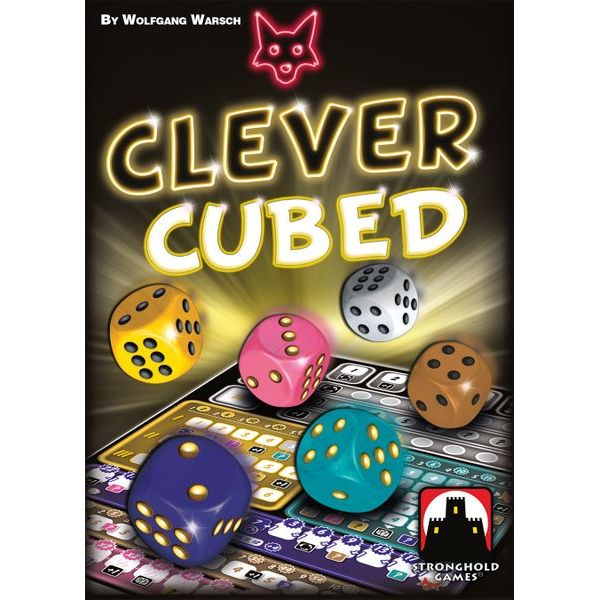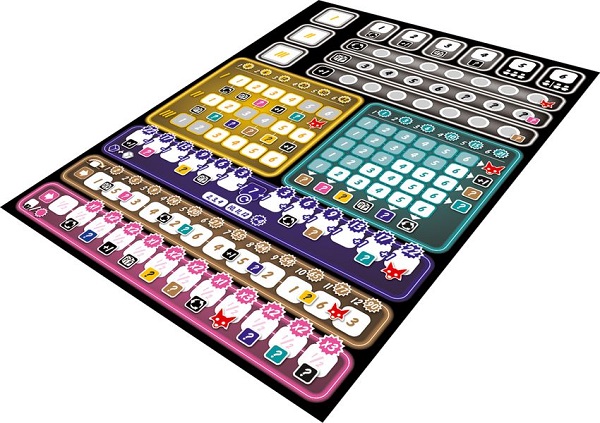Clever Cubed: Dice Served Up On A Silver Platter

Clever Cubed is a layered and elegant roll-and-write game in which players are trying to maximize points on five different scoring tracks.
Published by Stronghold Games and designed by Wolfgang Warsch (The Mind, Wavelength), Clever Cubed requires you not just to keep an eye on your own sheet but your opponents' as well, as you serve them up dice on a silver platter.
Gameplay
Each player takes a player sheet. On your turn, you roll all six dice. Five of the dice are each a unique color that corresponds with one of the five colored scoring tracks on your player sheet. The sixth die is white, which acts as a wild color and can be applied to any of the scoring tracks.
After you roll the dice, you choose one and place it on the first of three slots in the corner of your player sheet. You then perform the die’s action based on its color, marking a box in the correct scoring track. After you have selected your first die, any dice whose numbers are lower than the die you selected are placed on the silver tray printed into the game box. You then roll any remaining dice. You do the same thing a second time: select a die, perform its action, and place any dice with lower results than the die you just selected onto the silver tray. If there are still dice left over, you then do this a third and final time. Next, all the other players at the table may choose one die from the silver tray to perform its action. More than one player can choose the same die. A player can choose not to select die from the silver tray. However, if a player cannot legally use any of the dice on the silver platter, instead he may choose one of the dice that you selected.
Each colored scoring track works in a different way. Yellow has three rows, with the boxes numbered one through six for each row. You can only mark off a box if the number on your die matches the number in the box, and whether it is the first, second, or third die you chose this turn determines which row you can mark off. If it is not your turn and you chose a yellow die from off the silver tray, you may only mark one of the boxes that is colored in gray. Players earn points at the end of the game for each row based on how many boxes are marked off in that row. You can also earn bonuses for marking off the same numbered boxes in two adjacent rows.
For the light blue zone, there are five rows of six columns, with each box in each column showing the same number, one through six. When you choose a light blue die, you mark off one box that shows the number of that die for each die of the same number you have selected this round. If you chose the die from the silver tray, you get to mark off one box of that number for each die on the tray that shows that number. At the end of the game you score points for the number of boxes you’ve marked off for each number. Completing a certain number of boxes in each row and column also earns you bonuses.
For the dark blue area, you start at the seven that is in the middle of the scoring track. When you choose the dark blue die you add its result to the white die’s result and then write that number either to the left or the right of the next open space on the track. If it is to the left it must be one number lower than the last number written, and to the right it must be one number higher. You can also always reset either direction with a seven, but you get bonus points when the numbers reach a certain value in either direction. You score points for how far you get in either direction and filling in certain boxes earn you bonuses.
For the brown score track you start at the far left. In order to mark off a box, you must select the brown die when it shows the number result required for that box. You can skip a box, but once you skip it you may not go back. You score points for the number of boxes you mark off. You also earn a bonus for marking off certain adjacent boxes.
Finally, for the pink scoring track, when you mark off a box you may either write in half the value of the pink die’s result and then earn the bonus associated with that box, or you may multiple the die’s result by the number that is written above the box and earn points equal to that new number.
Bonuses vary, which can include writing in any number in a certain scoring track or allowing you to reroll all the dice you just rolled on your turn. Some of them will also earn you a fox. At the end of the game, each fox you earn is worth points equal to your lowest scoring score track.
You play a certain number of rounds based on player count. You then count up your points for each color and the player with the most points wins the game.

Review
Clever Cubed packs a lot of gameplay into thirty minutes. It’s layered, tricky, and challenging. Although it is borrowed from the game's predecessor, That's Pretty Clever, the silver platter mechanism is quite interesting — it really makes you think before you draft each die on your turn. Not only do you need to consider how many dice you’ll have left for your next roll, but you also need to think about what it’s putting at the disposal of your opponents. You want as many options as possible for yourself while limiting those other players will be able to choose from. This leads to some very solid player interaction, even while players are working to complete their own sheets.
Each scoring track acts in such a unique, individual way. The bonuses they unlock are important, but you also can’t simply ignore an entire track, as that will massively devalue your foxes, and those can be quite powerful in boosting your score. All of this ensures that you have lots of interesting choices to make each turn, even on an opponent’s turn when you’re selecting a single die from the tray.
This is a game that’s going to take some time to teach as you have to go through how each color scores. The first few times you play the game, you’re also probably going to need some reminders. The iconography on the player sheets does what it can, but it’s still not entirely intuitive what it all means so players are going to have questions. In fact, the player sheet can look a bit overwhelming at first glance.
Clever Cubed is not a roll and write that’s easy to pull out and dip into. It’s a challenging game full of thoughtful decisions. It takes several playthroughs before you start to develop solid strategies. It does, however, make it quite satisfying when you do manage to complete the game with high scores, and that also makes the solo mode an engaging variant. If you’re looking for a roll and write with a little more meat to it, without being too long, this is an excellent option.
Pros: Range of ways to score, player interaction, relatively short game time despite depth of play
Cons: Takes a while to teach, learning curve, lacks the simplicity and accessibility of some roll and writes
Disclosure: we received a complimentary review copy of this game.






